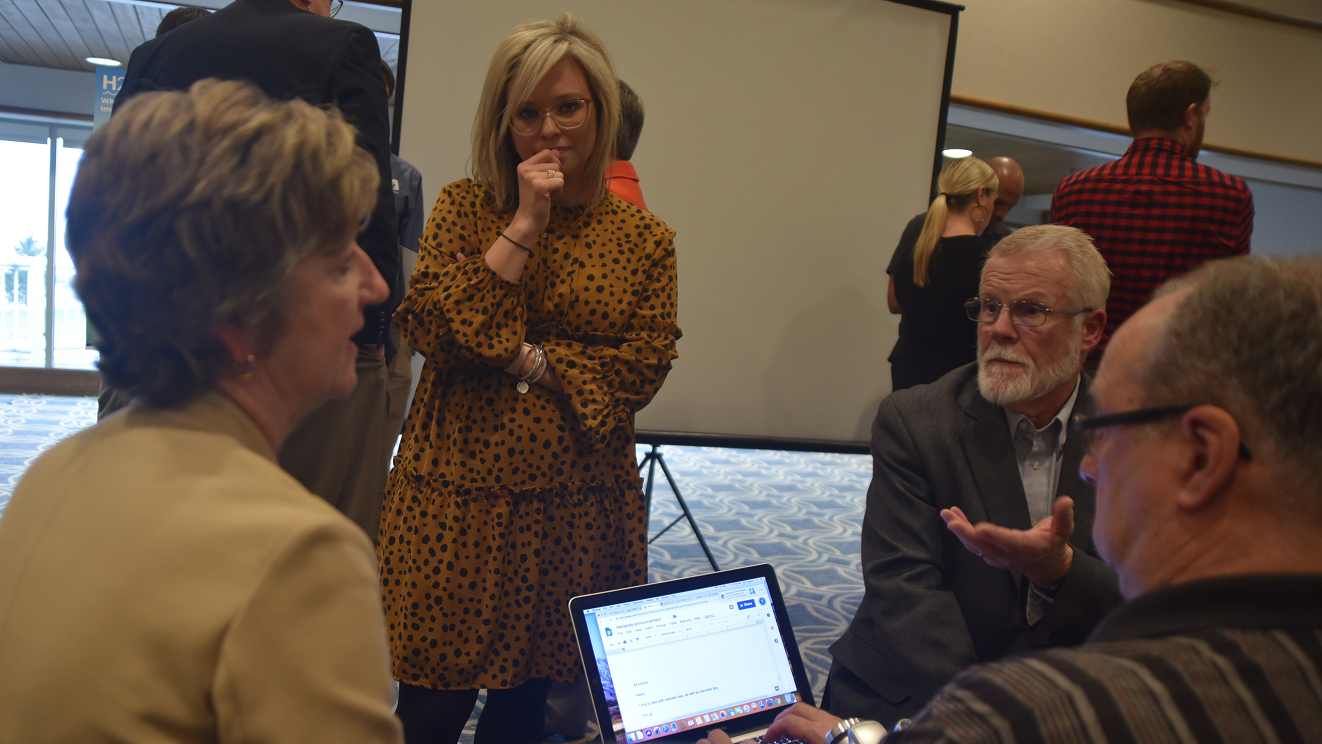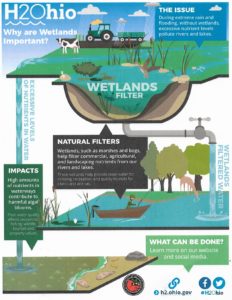
Through Ohio Gov. Mike DeWine’s recently unveiled H2Ohio plan, Ohio’s wetlands are getting a massive funding boost.
The plan calls for an almost $1 billion investment in clean water during the next decade, with a major component of that investment going to restoring and creating wetlands.
H2Ohio will provide $172 million over the first two years, according to Ohio Department of Natural Resources Director Mary Mertz.
The ODNR is slated to get a lion’s share of it, with $46 million allocated during the first year of Ohio’s two-year budget, a move aimed at improving the water quality not only in streams, but long-term water quality in Lake Erie as well.
On Nov. 21, Mertz unveiled the initial six projects at a public presentation at Maumee Bay State Park. These first projects were chosen from more than 20 that are set to begin during the next several years.
“We’re going to be improving wetlands that are already there, trying to use them more effectively, trying to redirect more phosphorous-laden water through them,” she said, adding that the ODNR is collaborating with government agencies, private organizations and universities. “We hope to focus on projects that will focus on measurable nutrients reduction in priority areas. These will be the first and we’re excited to talk about them today.”
Mertz said she hopes DeWine’s generous funding will lead to positive changes in the first few years, and continued support.
“That’s big chunk of the available funding. That’s what the governor asked for because he knew we would be ready to go and have projects on the ground and be ready to start moving,” Mertz said.
The Ohio Department of Agriculture and the Ohio Environmental Protection Agency will also receive a portion of the initial $172 million.
“That still leaves $90 million the second year,” Mertz said. We all work together a lot, the three agencies, so we’ll see how it progresses and what we’ll do with next year’s money.”
Partners in the projects include Metroparks Toledo, The Nature Conservancy, Black Swamp Conservancy and the Toledo-Lucas County Port Authority. Mertz highlighted six projects that are considered “shovel-ready.” Almost 20 other projects already in planning and engineering stages will follow the first six.
Conservationists have northwest Ohio in their sights
Ohio is second only to California as states with the greatest historic wetlands lost, with about 93 percent of the natural filters long since gone. The Great Black Swamp once covered about 1,500 square miles in the region. Since the 19th century it has been almost completely drained and converted for agriculture and development.
Christina Kuchle, northwest region scenic rivers manager with ODNR’s Division of Natural Areas and Preserves, said that at one point almost all of northwest Ohio was either forest or forested swamp.
“We made some changes. At the time that the Great Black Swamp was in its prime, it was a rational choice to drain it,” she said, calling it a formidable place to live. “The Native Americans didn’t even live within the confines of the swamp because water was everywhere.”
As a result of the drained swamps and creation of fertile farmlands, the flow volume of the Maumee River has doubled, Kuchle said.
“The way water moves across our landscape has changed, because we’ve lost the Great Black Swamp and so now we have this great opportunity through H2Ohio to put wetlands back on the landscape in our river systems,” she said.
While the individual projects aren’t large-scale, acreage-wise, combined they were selected to provide maximum benefit for troubled waters – especially Lake Erie, which has suffered from a string of annual harmful algal blooms in recent years.
The first six wetlands projects
- Oak Openings Preserve Metropark expansion, Lucas County: 37 acres
This critical headwaters restoration project is located in Metroparks’ 4,000-plus acres, a hotspot for biodiversity. One-third of all the state’s rare and endangered plant and animal species are located in the Oak Openings region, which is less than half of one percent of Ohio’s land area.
Forested wetlands restoration will include planting 15,000 hardwood trees and will capture and retain nutrients from agricultural lands nearby and run-off from paved roads. It will also provide recreational use to the public and add about 1,000 acres already restored or currently under restoration. It will also include 8 acres of new prairie/savanna habitat along Ai Creek.
- Redhorse Bend Preserve wetlands restoration, Sandusky County: 55 acres
Former agricultural acreage on a Sandusky River floodplain will provide natural filtration during high water events. Two ditches will be reconfigured to resemble and perform like more natural headwater streams, carrying and processing stormwater runoff and providing wetlands habitat.
- Maumee Bay State Park wetlands restoration, Lucas County: 137 acres
A landscape dominated by invasive phragmites on the Lake Erie shoreline will be returned to a natural marsh with native vegetation. The acreage will be reconnected to the lake so that nutrient loads from the lake will enter the marsh to be naturally extracted from the water before it returns to the lake.
- Maumee River Forder Bridge, Paulding County: 54 acres
This project will create a series of wetlands along an intermittent stream which is a Maumee River tributary. The project will replace a stream channel which sees high flow volume during storm events with a number of wetlands pools designed to slow and filter water. It will also provide wildlife and headwater stream habitat.
- Grassy Island and Cullen Park flow-throughs, Lucas County: 175 acres combined
These two projects, located at the mouth of the Maumee River, will be designed as shallow water areas with beneficial vegetation to filter nutrients from water. The projects are expected to remove up to 10 metric tons of phosphorous per year and provide 175 acres of fish and wildlife habitat. Up to 4 percent of the Maumee River’s flow is expected to enter, and linger, in the two areas before being discharged into Lake Erie.
“More than just a pool”
An existing marsh on Port Clinton’s waterfront is currently undergoing restoration, including the addition of a small section of new wetland.
The Port Clinton Lakeshore Preserve, at about 12 acres, is not among the suite of projects in the H2Ohio plan, though it is representative of the labor-intensive, long-term manner in which marshes are created or restored. Before the restoration began, the preserve was at times almost completely inundated with the aggressive, fast-growing invasive phragmites.

The Port Clinton Lakeshore Preserve site on the Lake Erie shore, is a downtown marsh under restoration, Photo by James Proffitt
“Part of it is the invasive species removal; the other part is the development of channels and pools. It provides different elevations within the marsh, so it’s something more than just a pool,” explained Tyson Yeager, who is helping oversee U.S. Army Corps of Engineers contractors on the project.
“We’ll bring in some native plant species for some of the mounds and dunes. We did a couple mowings and treatments for phragmites, because part of the goal is to remove the invasive species.”
Large pumps help keep water in the marsh to minimal levels while a small army of excavators, dump trucks and tracked hauling equipment move soil or, rather, thick black mud. While the marsh is not physically connected to the lake via water, its level will rise and fall with the lake’s natural cycles.
“It’s only connected hydrologically through the groundwater or the hydraulic pressure from the lake,” Yeager said. “It equalizes pretty quickly, we’ve found, in a couple days.”
The excavation is planned for this winter, with planting beginning next spring.
“The contract calls for a certain percentage of success with the plants, so if they don’t thrive they’ll come back and plant some more,” Yeager said. “And after that, there will be monitoring for several years to make sure we’re getting a success rate.”
Everyone on board with big spending on marshes
“That’s what it’s all about, is the collaboration,” said State Rep. Jim Hoops (R-Napoleon). “Gov. DeWine is very passionate about the Great Lakes and the water. The legislature supports it wholly and now it’s time to get to work. We really look forward to working with everybody here. I really believe northwest Ohio is what it is because of the Great Lakes.”
Joe Cappel, TLCPA vice president of business development, said his organization sees more than commerce and development in its mission.
“A lot of people, when they think of the Port Authority, they think of industry, and while that’s certainly a part of our quality of life, part of the river and the lake are marine transportation. But also clean drinking water, the fish and the environment, this is all part of our quality of life. Let’s not forget about recreational boating, eco-tourism, kayaking, canoeing, charter fishing,” he said.
Mertz said the H2Ohio push for marshes also has support from farmers.
“I think the agriculture community knows they’re part of the solution, and the administration has gotten great feedback from a lot of the commodity groups and the producers up here,” she said. “They know they have a job to do and they’re ready to do it and we’re ready to provide the financial backing to enable them to do that.”
Mertz cited legacy phosphorous as something farmers can’t fight, and that’s where the dozens of wetlands projects on the horizon come into play.
“We’re really excited and we feel like we’re moving as quickly as we can and we’re going to get these projects on the ground and I think they’re going to show some good results. We’ve done a lot of research here in Ohio,” she said. “We have a lot of scientists involved in this and if something’s not working, we’re going to change it.”





